What is it that feeds our battle, yet starves our victory?
OK Let’s Have Some Fun
Let’s nominate people from this site for positions in the 47 administration!
E.g., Scott for Press Secretary (assuming they don’t go with Kayleigh again). Imagine the YSM Jurinalists getting the Scott treatment!
Our Turn
We’ve often seen that quote from David Plouffe: “It is not enough to simply beat Trump. He must be destroyed thoroughly. His kind must not rise again.”
This was of course a declaration of intent to annihilate not just Trump, but rather “his kind.”
You know what? I think we should flip it around. David Plouffe’s kind should be destroyed thoroughly and their kind must not rise again.
What is Plouffe’s kind? I suppose it depends on who’s talking and what they are thinking of in particular. Well, at the moment it’s me talking and I am thinking of the sort of maggot who is attracted to politics not to better his world but rather so that he can wield power over others, or line their pockets with “free” money. Often these people end up as what Ayn Rand called “pull peddlers,” receiving money in exchange for using their connections to do favors.
This type is parasitic. Utterly parasitic. And they should be destroyed thoroughly and not allowed to rise again.
The bad news is we will never eradicate them. Useless turds who can’t do anything productive will always be with us. As will the outright sociopaths.
Of course they find Trump to be their enemy. And of course they find us to be their enemy. If we won’t simply lie down and let our “betters” have their way with us, we’re a problem, we’re something to be got rid of. And of late, we haven’t lain down without a protest, as we are “supposed” to do. Dang uppity Garbage Deplorables! We don’t know our place!!!
The good news is we can provide far fewer niches for these parasites. The niches come into being when something that people formerly did of their own free will is taken over by the government; then every aspect of that activity becomes a political football.
Take for instance education. Since the government runs it, if you don’t like what’s being done, you have to form a political movement and try to work your way around the maggots embedded in the bureaucracy. If education were private, then if you didn’t like what they were doing to your child, you’d take your money and your child elsewhere. And people who didn’t even have school-age children presently would have no voice–and not have to pay money. Making it a government “thing” turned it into a political thing, and the maggots began to swarm.
So we wreck them by seriously cutting government and giving them fewer places to exist. Among all of the other benefits, the body politic would have fewer sociopaths and parasites in it.
People like Plouffe are the same type, but they are the full-on political hacks who set policy, rather than implement it. They’re just as bad if not worse; they help government grow, and steer it into serving its own ends, rather than those of the people it is supposed to be serving.
The Deep State is nothing more than a government that serves its own ends.
And we have had enough of this.
They must be destroyed thoroughly, and their kind must not rise again.
This election wasn’t the end, it was the beginning. There are millions of these malignancies in this country and we’ve just defeated two of them. Keep pushing. Now we can go after them wholesale.
It’s our turn.

Our turn.

Our turn.

OUR TURN!
You stole the 2020 election. You’ve mocked and ridiculed and put people in prison and broken people’s lives because you said this thing was stolen. This entire phony thing is getting swept out. Biden’s getting swept out. Kamala Harris is getting swept out. MSNBC is getting swept out. The Justice Department is getting swept out. The FBI is getting swept out. You people suck, okay?! And now you’re going to pay the price for trying to destroy this country.
And I’m going to tell you, we’re going to get to the bottom of where the 600,000 votes [are]. You manufactured them to steal this election from President Trump in 2020. And think what this country would be if we hadn’t gone through the last four years of your madness, okay? You don’t deserve any respect, you don’t deserve any empathy, and you don’t deserve any pity.
And if anybody gives it to you, it’s Donald J. Trump, because he’s got a big heart and he’s a good man. A good man that you’re still gonna try to put in prison on the 26th of this month. This is how much you people suck. Okay? You’ve destroyed his business thing. And he came back.
He came back in the greatest show of political courage, I think, in world history. Like, [Roman statesman] Cincinnatus coming back from the plough [returning to politics to rescue the Roman Republic]. He’s the American Cincinnatus. And what he has done is a profile in courage. We’ve had his back. But I got to tell you, he may be empathetic. He may have a kind heart. He may be a good man. But we’re not. Okay? And you deserve, as Natalie Winters says, not retribution, justice. But you deserve what we call rough Roman justice, and we’re prepared to give it to you.
Steve Bannon, on election night
OUR TURN!!
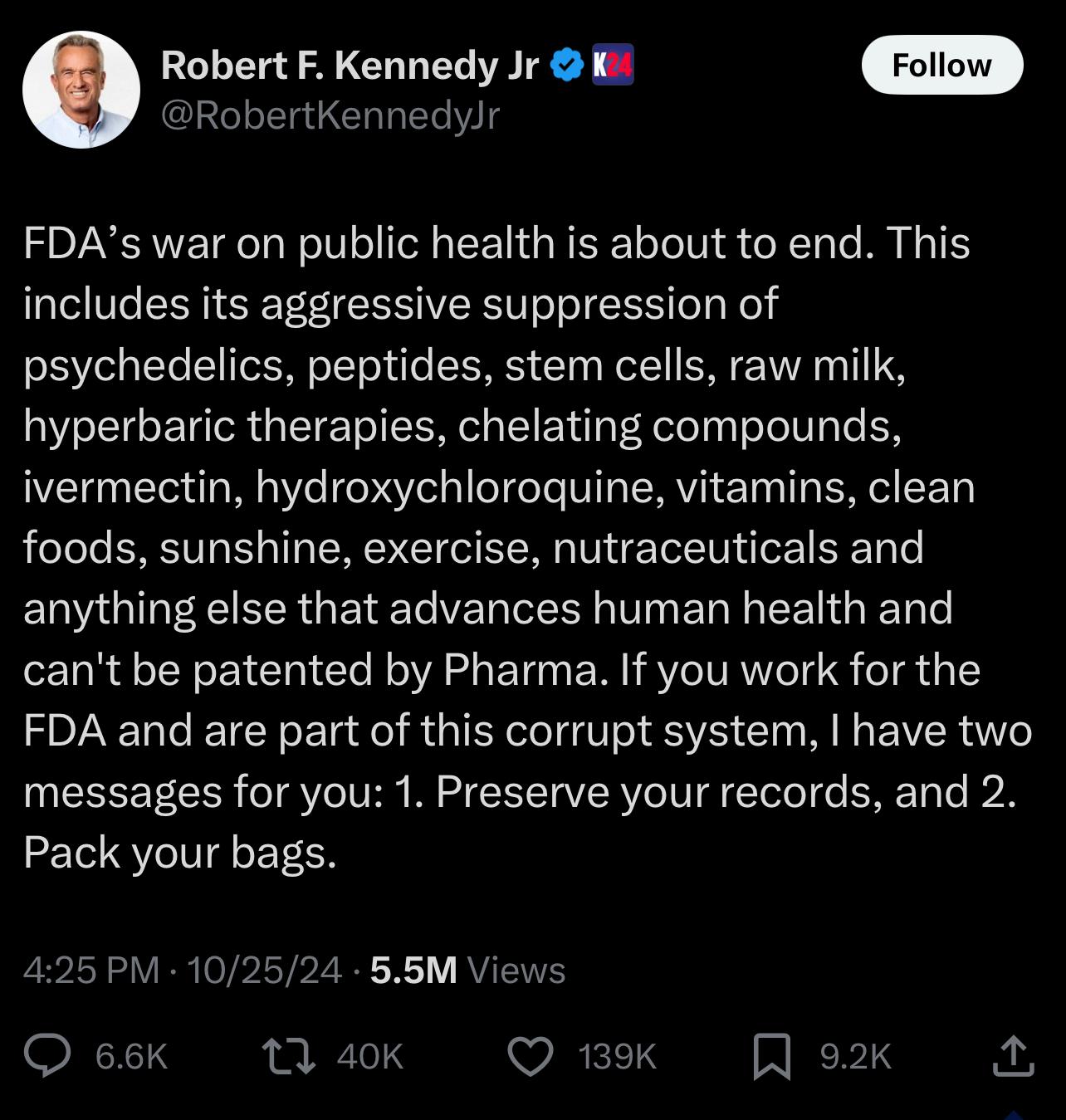
OUR TURN!!!

OUR TURN!!!
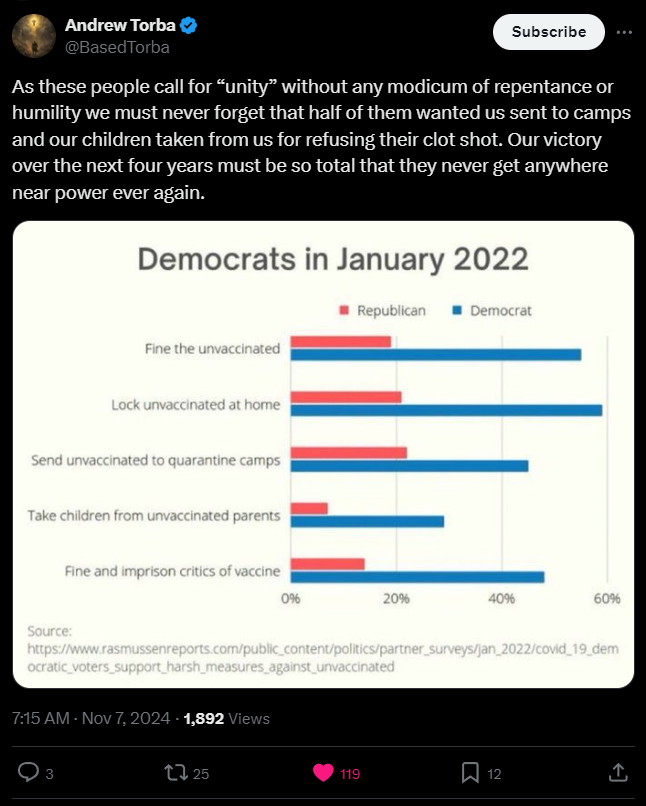
OUR TURN!!!
January 6 Tapes?
Paging Speaker Johnson…this is your conscience calling you out on broken promises.
For all your high talk about your Christian moral background…you’re looking less and less like you have any kind of moral background.
If You are a Patriot and Don’t Loathe RINOs…
Let’s talk about RINOs, and why they are the lowest form of life in politics.
Many patriots have been involved with politics, often at the grassroots, for decades. We’ve fought, and fought, and fought and won the occasional illusory small victory.
Yet we can’t seem to win the war, even when we have BIG electoral wins.
I am reminded of something. The original Star Trek had an episode titled Day of the Dove. It was one of the better episodes from the third season, but any fan of the original series will tell you that’s a very low bar. Still, it seems to get some respect; at a time when there were about 700 episodes of Star Trek in its various incarnations out there, it was voted 99th best out of the top 100.
In sum, the plot is that an alien entity has arranged for 39 Enterprise crew, and 39 Klingons, to fight each other endlessly with swords and other muscle-powered weapons. The entity lives off of hostile emotions, you see and it wants a captive food source. (The other 400 or so Enterprise crew are trapped below decks and unable to help.) Each side has its emotions played and amplified by the alien entity; one Enterprise junior officer has false memories implanted of a brother who was killed by Klingons. The brother didn’t even exist.
Even people killed in a sword fight miraculously heal so they can go do it again.
The second best line of the episode is when Kang, the Klingon captain, notes that though they have won quite a number of small victories including capturing Engineering, can’t seem to actually finally defeat the Enterprise crew. He growls, “What power is it that feeds our battle yet starves our victory?*”

Indeed. He may have been the bad guy, but his situation should sound familiar.
We are a majority in this country. We have a powerful political party in our corner. There is endless wrangling.
And yet,
What power is it that feeds our battle yet starves our victory?
In our case, that power is the RINOs in our midst. They specialize in caving when on the verge of victory. Think of Obamacare’s repeal failing…by one Republican vote. Think of the way we can never seem to get spending under control (and now our entire tax revenue goes to pay interest on the debt; anything the government actually does now is with borrowed money).
We have a party…that refuses to do what we want it to do, and that refusal is institutionalized. If you’ve been involved with GOP politics, but haven’t seen this, it’s because you refuse to see it. Or because you are part of the problem yourself. (If so, kindly gargle some red fuming nitric acid to clear the taste of shit out of your mouth, and let those not part of the problem alone so they can read this.)
We fight to elect people, who then take a dive when in office. But it’s not just the politicians in office, it’s the people behind the scenes, the leaders of the national, state and county branches of the party. Their job is to ensure that real patriots never get onto the general election ballot. They’re allowed a few failures…who can then become token conservatives who will somehow never manage to win (Jordan), or can be compromised outright (Lauren Boebert?).
That way it doesn’t actually matter who has a congressional majority. I remember my excitement when the GOP took the Senate in 1980. But all that did was empower a bunch of “moderate” puddles of dog vomit like…well for whatever reason forty years later the most memorable name is Pete Domenici. And a couple of dozen other “moderates” who simply had no interest in doing what grassroots people in their party–those same grassroots people who had worked so hard to elect them–wanted them to do.
Oh, they’ll put up a semblance of a fight…but never win. And they love it when we fight the Dems instead of fighting them. Just like that alien entity, whose motto surely was “Let’s you and him fight. It’ll be delicious!”
If you think about it, your entire political involvement has come to nothing because of these walking malignant tumors.
That should make you good and mad.
The twenty five who blocked Jordan, and the hundred people who took that opportunity to stab Jordan in the back in the secret ballot should make you good and mad.
I’ll close this with another example of RINO backstabbing, an infuriating one close to home.
In my county, the GOP chair is not a RINO. She got elected when the grassroots had had enough of the RINOs. Unfortunately the state organization is full of RINOs, and the ousted county RINOs have been trying to form a new “Republican Party” and get the state GOP to recognize them as the affiliate. I’m honestly amazed it hasn’t happened yet.
In other words those shitstains won’t just leave when they get booted out; they’ll try to destroy what they left behind. It’s an indication that they know we know how important that behind-the-scenes party power is.
So they must be destroyed. That’s the only way they’ll ever stop.
We cannot win until the leeches “on our side” get destroyed.
What power is it that feeds our battle yet starves our victory?*
We know it. What is going to be done about it?
*NOTE: The original line was actually “What power is it that supports our battle yet starves our victory.” I had mis-remembered it as feeds. When I checked it, it sure enough was “supports” and that’s what I originally quoted. On further reflection, though, I realized my memory was actually an improvement over the reality, because feeds is a perfect contrast with starves. I changed it partway through the day this originally posted, but now (since this is a re-run) it gets rendered this way from the start.
If one must do things wrong, one should do them wrong…right.
RINOs an Endangered Species?
If Only!
According to Wikipoo, et. al., the Northern White Rhinoceros (Ceratotherium simum cottoni) is a critically endangered species. Apparently two females live on a wildlife preserve in Sudan, and no males are known to be alive. So basically, this species is dead as soon as the females die of old age. Presently they are watched over by armed guards 24/7.
Biologists have been trying to cross them with the other subspecies, Southern White Rhinoceroses (Rhinoceri?) without success; and some genetic analyses suggest that perhaps they aren’t two subspecies at all, but two distinct species, which would make the whole project a lot more difficult.
I should hope if the American RINO (Parasitus rectum pseudoconservativum) is ever this endangered, there will be heroic efforts not to save the species, but rather to push the remainder off a cliff. Onto punji sticks. With feces smeared on them. Failing that a good bath in red fuming nitric acid will do.
But I’m not done ranting about RINOs.
The RINOs (if they are capable of any introspection whatsoever) probably wonder why they constantly have to deal with “populist” eruptions like the Trump-led MAGA movement. That would be because the so-called populists stand for absolutely nothing except for going along to get along. That allows the Left to drive the culture and politics.
Given the results of our most recent elections, the Left will now push harder, and the RINOs will now turn even squishier than they were before.
I well remember 1989-1990 in my state when the RINO establishment started preaching the message that a conservative simply couldn’t win in Colorado. Never mind the fact that Reagan had won the state TWICE (in 1984 bringing in a veto-proof state house and senate with him) and GHWB had won after (falsely!) assuring everyone that a vote for him was a vote for Reagan’s third term.
This is how the RINOs function. They push, push, push the line that only a “moderate” can get elected. Stomp them when they pull that shit. Tell everyone in ear shot that that’s exactly what the Left wants you to think, and oh-by-the-way-Mister-RINO if you’re in this party selling the same message as the Left…well, whythefuckexactly are you in this party, you lying piece of rancid weasel shit?
Justice
It says “Justice” on the picture.
And I’m sure someone will post the standard joke about what the fish thinks about the situation.
But what is it?
Here’s a take, from a different context: It’s about how you do justice, not the justice that must be done to our massively corrupt government and media. You must properly identify the nature of a person, before you can do him justice.
Ayn Rand, On Justice (speaking through her character John Galt, in Atlas Shrugged):
Justice is the recognition of the fact that you cannot fake the character of men as you cannot fake the character of nature, that you must judge all men as conscientiously as you judge inanimate objects, with the same respect for truth, with the same incorruptible vision, by as pure and as rational a process of identification—that every man must be judged for what he is and treated accordingly, that just as you do not pay a higher price for a rusty chunk of scrap than for a piece of shining metal, so you do not value a rotter above a hero—that your moral appraisal is the coin paying men for their virtues or vices, and this payment demands of you as scrupulous an honor as you bring to financial transactions—that to withhold your contempt from men’s vices is an act of moral counterfeiting, and to withhold your admiration from their virtues is an act of moral embezzlement—that to place any other concern higher than justice is to devaluate your moral currency and defraud the good in favor of the evil, since only the good can lose by a default of justice and only the evil can profit—and that the bottom of the pit at the end of that road, the act of moral bankruptcy, is to punish men for their virtues and reward them for their vices, that that is the collapse to full depravity, the Black Mass of the worship of death, the dedication of your consciousness to the destruction of existence.
Ayn Rand identified seven virtues, chief among them rationality. The other six, including justice, she considered subsidiary because they are essentially different aspects and applications of rationality.
—Ayn Rand Lexicon (aynrandlexicon.com)
Justice Must Be Done.
Trump, it is supposed, had some documents.
Biden and company stole the country.
I’m sure enough of this that I put my money where my mouth is.

The prior election must be acknowledged as fraudulent, and steps must be taken to prosecute the fraudsters and restore integrity to the system. (This doesn’t necessarily include deposing Joe and Hoe and putting Trump where he belongs, but it would certainly be a lot easier to fix our broken electoral system with the right people in charge.)
Nothing else matters at this point. Talking about trying again in 2024 or 2026 is pointless otherwise. Which is not to say one must never talk about this, but rather that one must account for this in ones planning; if fixing the fraud in the system is not part of the plan, you have no plan.
This will necessarily be piecemeal, state by state, which is why I am encouraged by those states working to change their laws to alleviate the fraud both via computer and via bogus voters. If enough states do that we might end up with a working majority in Congress and that would be something Trump never really had.
Lawyer Appeasement Section
OK now for the fine print.
This is the WQTH Daily Thread. You know the drill. There’s no Poltical correctness, but civility is a requirement. There are Important Guidelines, here, with an addendum on 20191110.
We have a new board – called The U Tree – where people can take each other to the woodshed without fear of censorship or moderation.
And remember Wheatie’s Rules:
1. No food fights
2. No running with scissors.
3. If you bring snacks, bring enough for everyone.
4. Zeroth rule of gun safety: Don’t let the government get your guns.
5. Rule one of gun safety: The gun is always loaded.
5a. If you actually want the gun to be loaded, like because you’re checking out a bump in the night, then it’s empty.
6. Rule two of gun safety: Never point the gun at anything you’re not willing to destroy.
7. Rule three: Keep your finger off the trigger until ready to fire.
8. Rule the fourth: Be sure of your target and what is behind it.
(Hmm a few extras seem to have crept in.)
Spot Prices
Last week:
Gold $2,736.50
Silver $32.51
Platinum $1,002.00
Palladium $1,124.00
Rhodium $4,950.00
FRNSI* 131.378+
Gold:Silver 84.174+
This week, at Friday close:
Gold $2,684.50
Silver $31.35
Platinum $979.00
Palladium $1,014.00
Rhodium $5,025.00
FRNSI* 128.863-
Gold:Silver 85.630-
No whitewashing it, the precious metals took as big a beating as the Democrats did. Gold dropped over $75 on Wednesday and though it partially recovered Thursday, it dropped again on Friday. It’s possible the bull market is over…let’s see what happens next week.
Notably, silver did even worse than gold; the ratio is now 85.6 to 1.
For someone who took a substantial loss in net worth this week, I sure seem to be in a cheerful mood. I wonder why?
*The SteveInCO Federal Reserve Note Suckage Index (FRNSI) is a measure of how much the dollar has inflated. It’s the ratio of the current price of gold, to the number of dollars an ounce of fine gold made up when the dollar was defined as 25.8 grains of 0.900 gold. That worked out to an ounce being $20.67+71/387 of a cent. (Note gold wasn’t worth this much back then, thus much gold was $20.67 71/387ths. It’s a subtle distinction. One ounce of gold wasn’t worth $20.67 back then, it was $20.67.) Once this ratio is computed, 1 is subtracted from it so that the number is zero when the dollar is at its proper value, indicating zero suckage.
The Grand Tour
Meet Gary Flandro (1934- ):

He’s an aerospace engineer, who is currently the professor for the Boling Chair of Excellence at the University of Tennessee Space Institute. He is also the Vice President and Chief Engineer for Gloyer-Taylor Laboratories (GTL).
He has an interesting academic “ancestry”–he studied under Frank E. Marble, who studied under Hans Wolfgangg Liepmann, who studied under Bar, who studied under Emil Hilb, who studied under Karl Louis Ferdinand von Lindemann (who proved in 1882 that pi is a transcendental number), who studied under Felix Christian Klein, who studied under Rudolf Otto Sigismund Lipschitz, who studied under Johann Peter Gustav Lejeune Dirichlet, who studied under Jean-Baptiste Joseph Fourier (yes, that Fourier), who studied under Joseph-Louis Lagrange (yes, that Lagrange), who studied under Leonhard Euler (yes, that Euler). Academics sometimes like to play “academic genealogy” (as do musicians; some can show that Beethoven or Haydn taught someone who taught someone who…(eventually)…taught them). Every one of these people has a Wikipedia page, with the exception of Bar, many are famous to mathematicians.
That’s cool. But it’s not the reason I chose to mention Flandro.
Flandro is the reason we have closeup pictures of Uranus and Neptune.
In 1964, he came to the realization that we were coming up on a very rare alignment of the outer planets. No, they weren’t going to be in a tidy straight line, but it would be possible to send a spacecraft past Jupiter, get a gravity assist from Jupiter to go to Saturn, then a gravity assist from Saturn to go to Uranus, and so on, on to Neptune and Pluto (still considered a planet back then).
Or, if one sends two spacecraft, get all of that done in less time, by sending one, launched in 1977 to Jupiter, Saturn and Pluto, and the other, launched in 1979, to Jupiter, Uranus and Neptune. This concept (with one modification) was dubbed the Grand Tour program, and was proposed in 1969. That modification was to send two pairs of spacecraft.
Total cost, $1 billion or so in real money, but cheaper than sending separate spacecraft. The biggest issue was that sending a probe of any useful size past Jupiter without any assistance is difficult; it still is. (All of these fancy Jupiter and Saturn orbiters needed gravitational assists to get there with enough fuel to do an orbital insertion burn and still have enough left over to make small maneuvers for many years.) This way, if you could get to Jupiter, you could automatically get to the other planets.
What’s not to like? The money.
Instead of four spacecraft, we’d send two Mariner-type probes. And we’d blow off Uranus, Neptune and Pluto…well, sort of. Now the project was called Mariner Jupiter-Saturn, which was approved in 1972, for $360 million apiece.
Both probes would visit Jupiter, Saturn, and Titan. (Titan was included because even then it was known to have an atmosphere, which made it unusual for a moon.)
That is what was advertised, to keep cost estimates down. Here’s what actually happened. The first probe was launched on a flight plan called JST: Jupiter Saturn Titan. The second was launched on a flight plan called JSX. JSX would visit Jupiter and Saturn, but if the first mission failed either at Titan or earlier, it could be diverted to visit Titan…and that would be it. If not diverted, however, it would not do a close flyby of Titan, but instead go on to Uranus and Neptune. The reason this wasn’t advertised is that controlling those spacecraft for the additional nine years would be expensive.
These would have been Mariner 11 and Mariner 12. The earlier Mariner probes had largely explored Mars; this would have been a continuation of that legacy. But these spacecraft had a lot of new features, and so in March, 1977 NASA held a competition to rename the project. And so, just months before launch they became Voyager 1 and 2. Voyager 1 would visit Jupiter and Saturn with a close flyby of Titan. Voyager 2 would visit Jupiter and Saturn, then Uranus and Neptune, but could be diverted if Voyager 1 failed either before or during the Titan flyby, since Voyager 2 would reach Saturn nine months after Voyager 1. (There was even an option to divert Voyager 1 away from Titan and send it to Pluto, but Titan was considered the more interesting target after Pioneer 11 saw just how thick its atmosphere was.)
Voyager 2 was launched first, on August 20, 1977, then Voyager 1 on September 5th, on a faster trajectory. It would actually overtake Voyager 2 and reach Jupiter on March 5, 1979 (barely a year and a half after launch!). Voyager 2 flew by on July 9, then both were off to Saturn. Voyager 1 reached Saturn on November 12, 1980 (shortly after the election), and flew by Titan later that day. The Titan encounter actually flung it out of the plane of the ecliptic, meaning Voyager wouldn’t be visiting any more planets. Voyager 2 was not diverted, and reached Saturn on August 26, 1981. And then Uranus on January 24, 1986, and Neptune on August 25, 1989, one day shy of eight years after the Saturn flyby.
So far Voyager 2 is the only spacecraft to ever fly by Uranus and Neptune.

Voyager 1 and Voyager 2 are still ticking, believe it or not, and Voyager 1 is now in interstellar space having passed outside of the Sun’s magnetic field. It’s returning data on the almost total vacuum of interstellar space. But, in the next two years (likely next year in fact) their RTG units will have degraded enough that they will no longer be able to power any of the scientific instruments. And ultimately they will be unable to maintain radio contact with Earth sometime in the 2030s; they will be out of range of our receivers.
(The RTGs on the Voyagers are slugs of plutonium oxide; the plutonium is isotope 238 (not the 239 used in bombs) which has an 87.7 year half life. The heat generated is converted to electrical power via thermocouples using the Seebeck effect. When new they generated 160 watts electrical, 2400 watts heat.)
Old Voyagers never die, they just fade away.
Voyager 1 is still moving at 16.9 km/sec relative to the sun; it crosses 3.57 AUs per year…almost the distance between Earth and Jupiter at its closest. Voyager 2 is moving at 15.2 km/sec. Their distances are 162 and 137 AUs, or 24.5 and and 20.5 billion kilometers.
And again, it is thanks to these stalwarts that we have any closeup pictures and data for Uranus and Neptune and their moons. Hubble and JWST can take occasional ganders, but there’s no substitute for being there, however briefly; and for now, this is what we’ve got.
Uranus
Uranus was spotted by John Flamsteed in 1690 as he created his star catalog. If you’ve ever seen a star with a name something like “61 Cygni” (a number and then a Latin genitive of a constellation name), that’s a Flamsteed designation. There are 84 of his designations that are today considered to have been mistakes; in particular “34 Tauri” was actually the planet Uranus.
Uranus was identified as a planet for the first time by William Herschel in 1781, his first thought was to name it after the King…As it happens, King George III; yes, that asshole. Good taste prevailed; we couldn’t get away from assholes apparently but at least it’s more egalitarian: It’s named after everyone’s asshole.
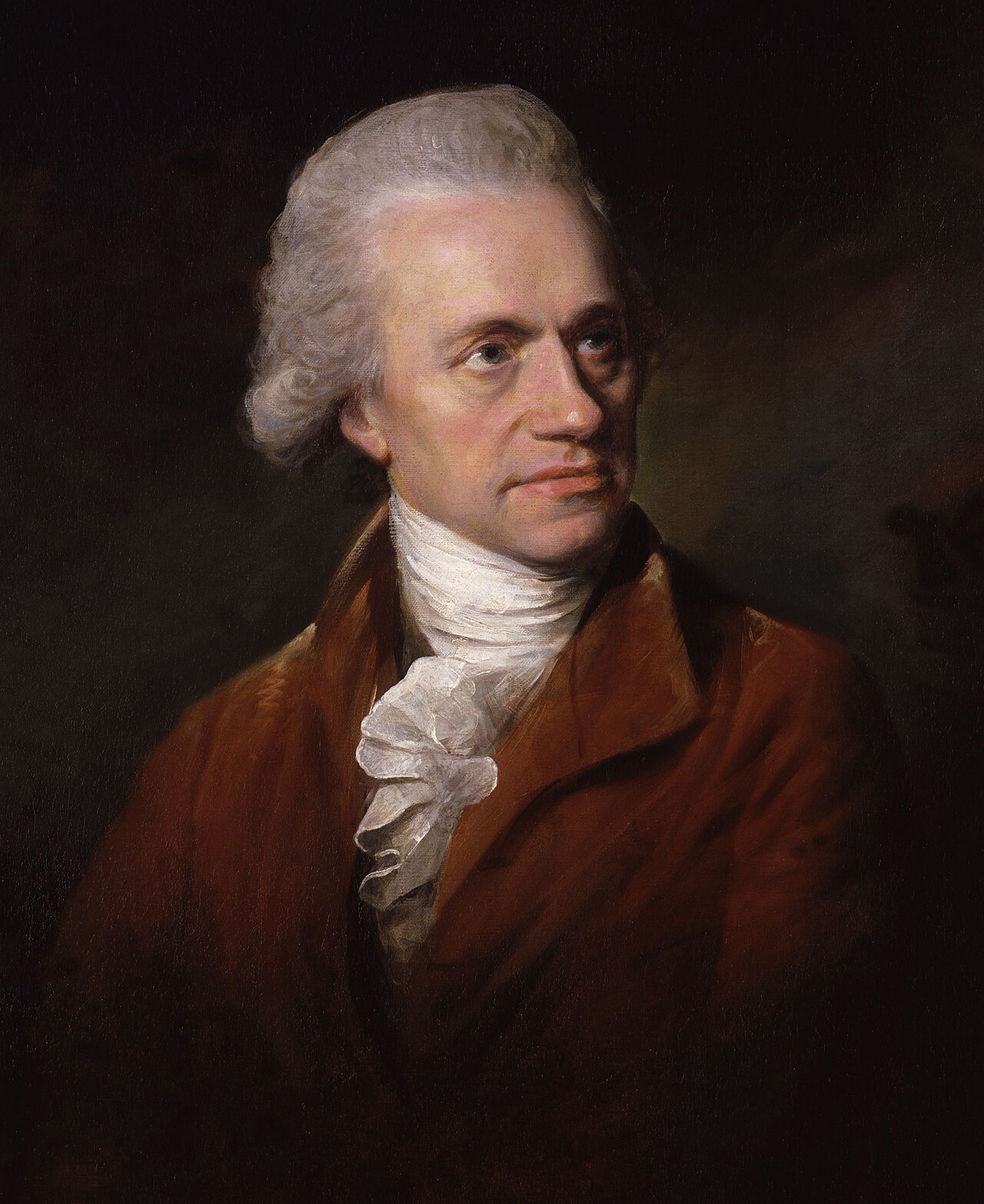
OK, more seriously it’s named after the Greek sky god, Ouranos (Οὐρανός). Ouranos was one of the primordial deities, along with Gaia (Earth), he was the father of the Titans…in particular Kronos (Saturn). Saturn in turn was the father of Zeus (Jupiter). So it’s a neat progression, one generation back every planet out from the Sun. (But with this we’re out of generations; nothing preceded Ouranos.
The usual pronunciation is “YER-in-us” rather than “your anus” but I don’t even care for that one (as it means “full of urine”) and would like to go with OO-rahn-ose which is closer to the Greek pronunciation. Not a battle I’m likely to win.
OK, some basic facts since this bit is a recap of the Hugh Janus post from several months ago.
First a picture, with Blue Marble Earth (with a non-fubared Red Sea) photoshopped in for a size comparison. This is a natural-color image of Uranus taken by Voyager 2:
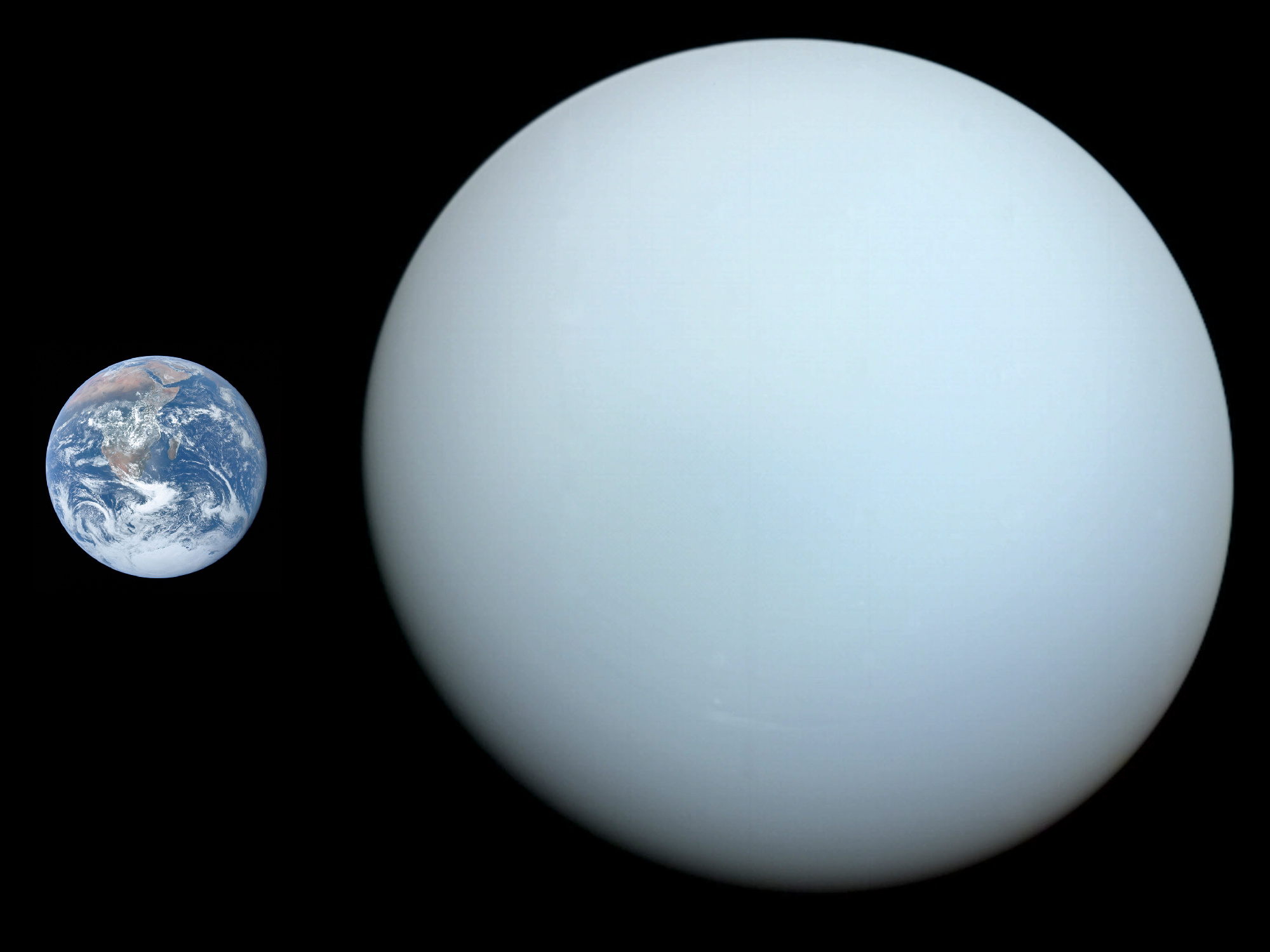
Well, that’s fascinating. We could probably argue over whether that’s more green than blue, or vice versa. It’s about as detailed as any true color image of Venus. Or Titan. More can be learned from false color images.
Uranus is 19.1 AU from the Sun, on average–about twice as far out as Saturn–and takes 84.02 Earth years to make one orbit around the Sun. It rotates once (relative to the Sun) in 17 hours, 14 minutes. However, here’s the thing: its axis of rotation is tipped 98 degrees from being perpendicular to its orbit (compare to our 23.5 degrees). Since axial tilts cause seasons, and this is almost as extreme as they get, Uranus has extreme seasons; at one point in its orbit almost the entire northern hemisphere has a midnight sun while the southern hemisphere gets no sun at all. And the poles get 42 years of continuous sunlight followed by 42 years of darkness (analogous to our poles getting six months of each). Because of these extreme seasons, Uranus has the lowest minimum temperature of any planet in the Solar System coming in at 49K.
This next graphic is a simulation of what Uranus looks like from Earth (hence just about what it looks like from the Sun) from 1985 to 2030, just a bit over half a Uranian year. The rings are included to provide a reference:

Uranus’s equatorial radius is 25,559 (give or take 4) km, compare to Earth’s 6,378. It has a mass 14.5 times that of Earth.
Uranus has multiple magnetic poles, and this likely has something to do with the fact that it is an “ice giant”
We’ve not dealt with ice giants before; these are gas giants (like Jupiter and Saturn) but with a heavier concentration of the molecules that planetary scientists call “ices” (even when they’re not frozen), water, ammonia, methane, sulfur dioxide, etc; generally hydrogen combined with some fairly small atom. Deep inside the planet all sorts of interesting forms of these compounds appear. In particular, water ice has many different polymorphs (different ways of crystalizing) under great pressure. Some of these even break the water molecules apart leaving oxygen crystallized and the hydrogen ions free to move through the lattice, others under greater pressure trap the hydrogen. It is thought that Uranus (and Neptune) have layers of the conducting ice deep inside and this is where the magnetic fields originate. Since the locations are relatively thin shells, it’s likely that multiple magnetic poles would form.
In some ways Uranus and Neptune resemble what you’d get if you removed the (mostly hydrogen and helium) outer layers from Jupiter and Saturn.
Uranus has rings; these were discovered in 1977. The discoverers were planning to watch Uranus pass in front of a star to hopefully learn something about Uranus’s atmosphere. They were surprised to see the star blink out five times before and afterwards, in symmetric patterns, which is what you’d see if an otherwise invisible ring was dimming the light. Later on they detected four more rings. The rings are made out of very dark objects about the size of a basketball (similar in size to Saturn’s rings’ constituents) and thus they couldn’t be seen directly. They’re named with Greek letters, sometimes numbers, and the names are not in any kind of logical order since they were assigned in discovery order.
Moons
Uranus has 28 known moons. The naming scheme is based on characters from Shakepeare and Alexander Pope.
We’ll start with an image taken by JWST; the big ones are bright blue, nine inner moons are also shown.
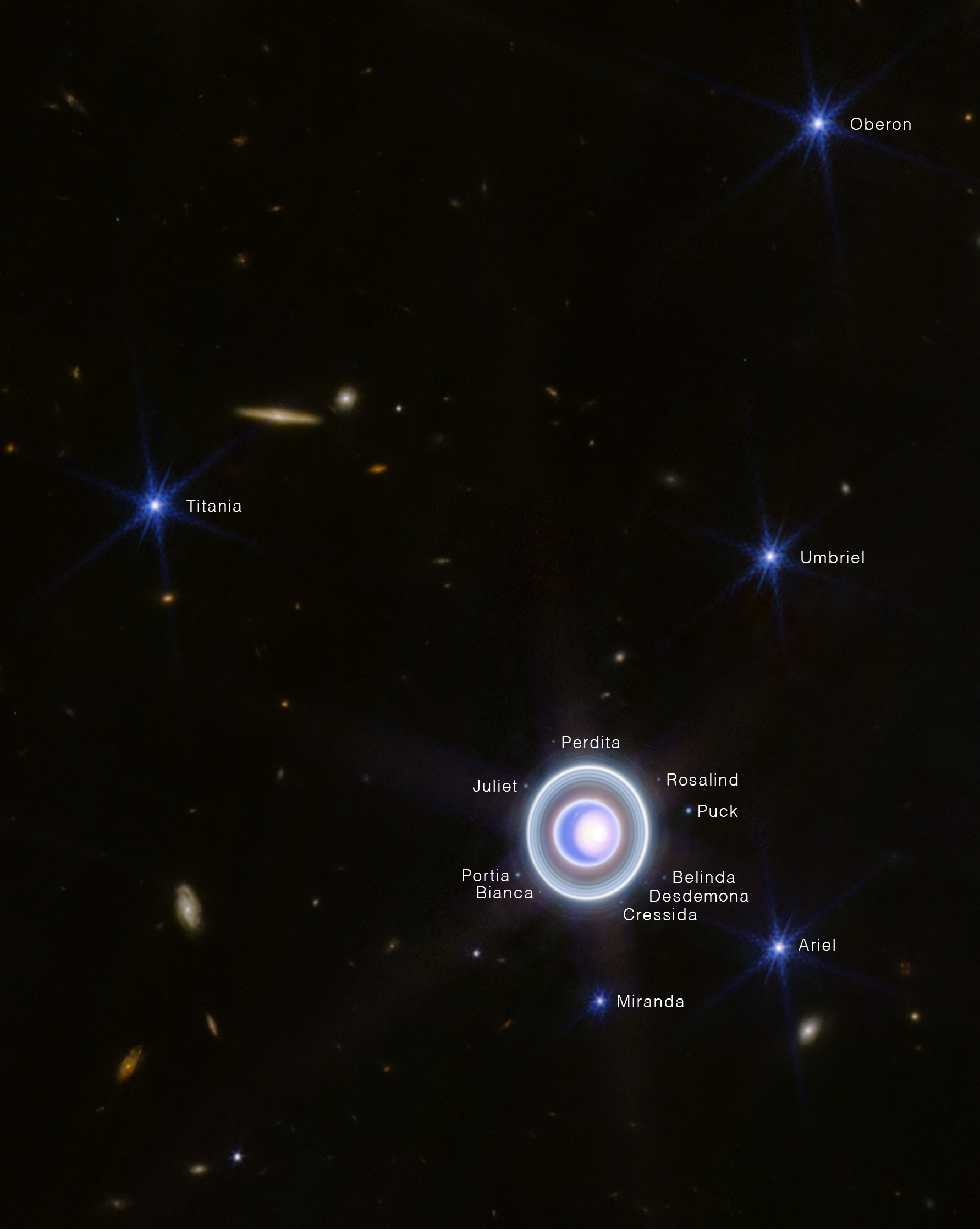
I learned Uranus had five moons in school, and these “original” five are four medium-sized major moons with one medium-small major moon.
Inner Moons
But we now know of 13 “inner moons” (small, non-round moons that orbit in nice circular orbits, closer than the major moons). That’s the most of any of the four giant planets. Working outward, we have Cordelia and Ophelia, which shepherd the ε (epsilon) ring. Then we have six at very similar distances forming a group: Bianca, Cressida, Desdemona, Juliet, Portia, and Rosalind. Then another close grouping of three: Cupid, Belinda, and Perdita. Finally there are Puck and Mab, Mab is likely the source of the μ (mu) ring.
We have a fuzzy picture with some detail for one of these moons, Puck:

All of these moons are involved with the ring system, which (unsurprisingly) is thought to have resulted from the fragmentation of other inner moons.
Major Moons
Then we come to the major moons; the five we heard about in school if you’re anything remotely my age. They are shown in this montage at the right relative sizes and brightness, in order of distance from Uranus.

They are: Miranda (471.6 km), Ariel (1157.8), Umbriel (1169.4), Titania (1577.8) and Oberon (1522.8). Titania at 1,577.8 km is just a bit bigger than Saturn’s Rhea, and is the largest “medium” moon. Titania and Oberon were discovered by Herschel in 1787, Ariel and Umbriel in 1851 by William Lassell, and Miranda by Gerard Kuiper in 1948. (And you will be seeing the name “Kuiper” a lot in the future.)
At the time Voyager 2 flew by the southern hemisphere of Uranus and each of its moons was oriented to the Sun, and we only got 20-40% coverage in the pictures…and we still don’t know what’s on the other sides of these moons!
These moons are fairly dark, by contrast with the bright moons of Saturn.
Miranda is mostly ice, while the other four seem to have significant rocky content:
The big four seem to all have salt water layers, underlain by hydrated water, and perhaps in the case of Titania and Oberon, dry rocky cores. I get the impression that all of this is somewhat speculative.
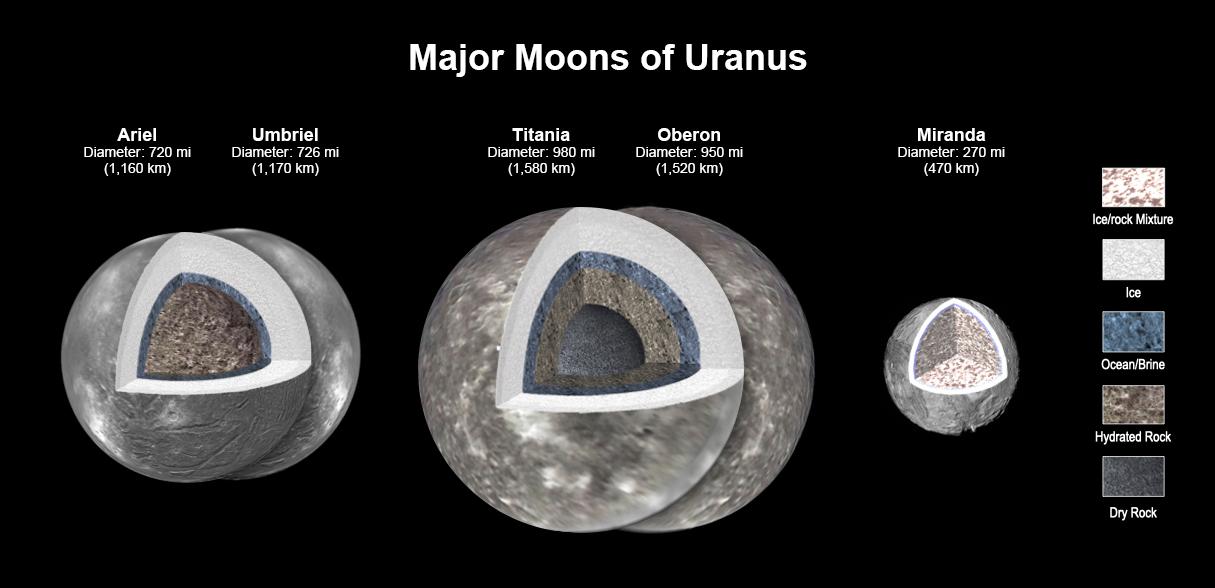
Miranda

Miranda is likely the most interesting of these moons, with fault canyons 20 km deep, terraced layers, and a patchwork chaotic surface of different ages and features. (We can tell the different ages from the different amounts of meteor craters.) Look at that picture; it looks like a Frankenmoon. Note that the canyons and mountains are large enough to be obvious bumps and cuts in what ought to be a circular outline. There is some speculation that this moon was broken apart and reassembled at some time in the past.
Of course I cannot think of Miranda without remembering the scene from Red Heat, where Ahnuld plays a Soviet policeman in the US to arrest and bring back Georgian thugs (no, the other Georgia, the one where they really talk funny). After roughing up one suspect and then being told that here in the US there are Miranda rights, warnings, etc…
Ariel
The highest resolution image of Ariel from Voyager 2 is this one:
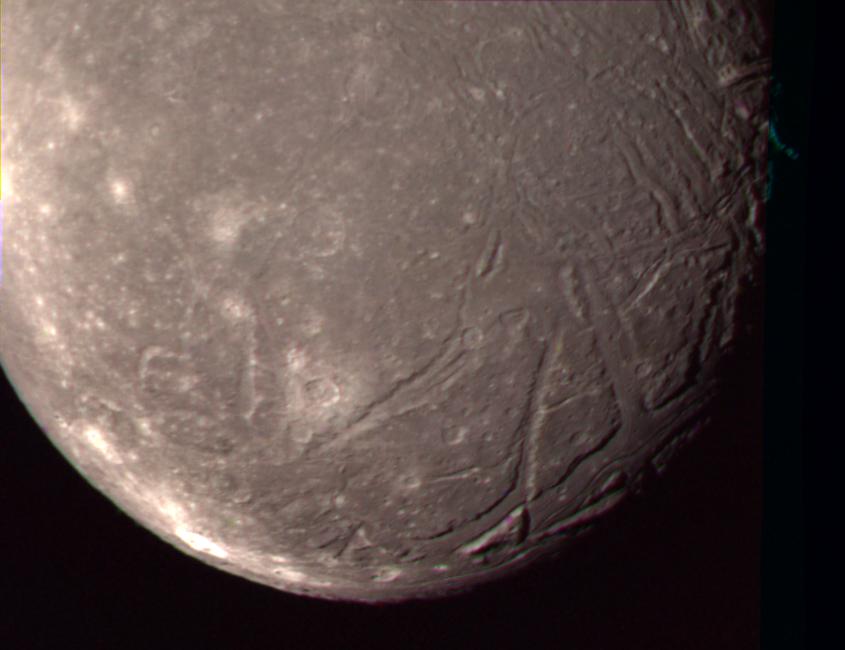
The broad channels to the lower right stand out, they’re called grabens and may be from liquid welling to the surface…sometime in the distance past.
Umbriel
Conveniently for those wanting to memorize names, Ariel and Umbriel rhyme which might help you remember they’re adjacent to each other in the list.
Umbriel is dark and heavily cratered, and as you can see the photo is a bit blurry. At the very top is the crater Wunda.
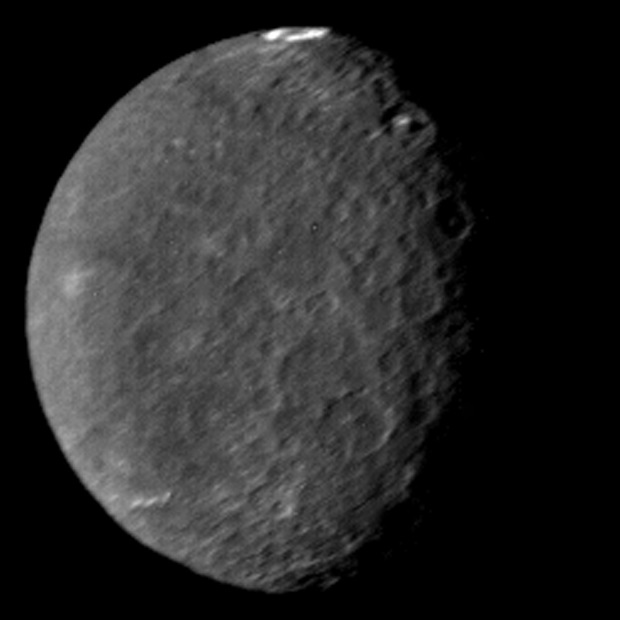
Titania
As mentioned before Titania is the largest “medium” sized moon, beating out Rhea by a slim margin. Water ice and a bit of carbon dioxide as dry ice have been detected. Again we have one not-very-high-res picture, and a slightly better one.
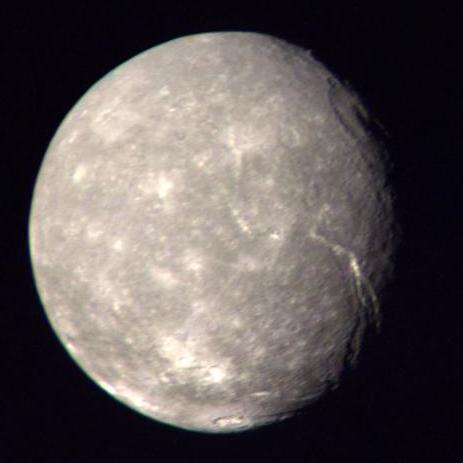
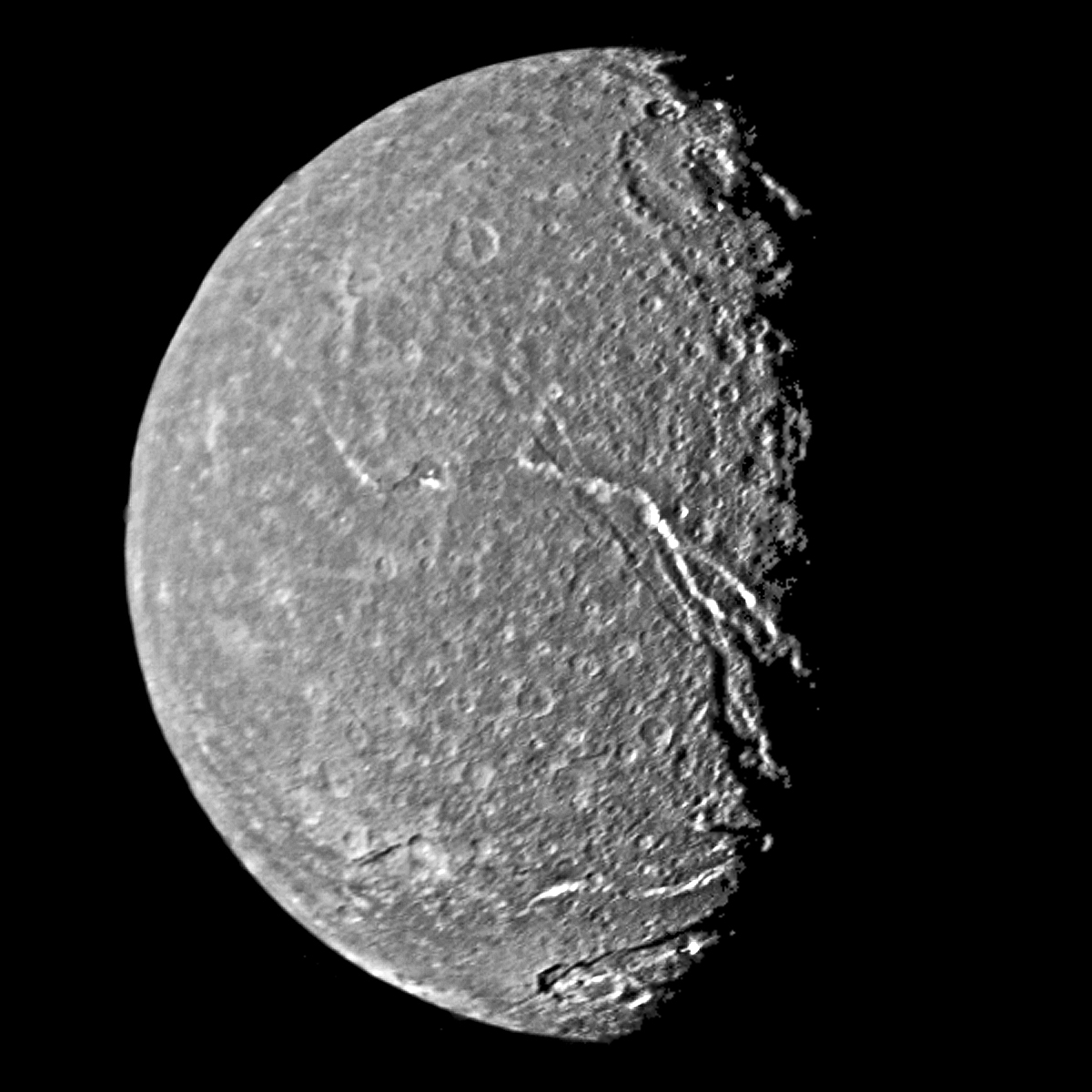
Oberon
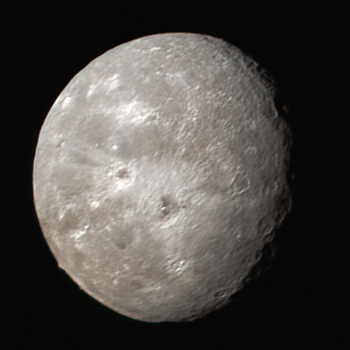
Oberon has a lot of bright patches, these are largely craters with bright rays. The largest of these is Hamlet, almost dead center in the photograph. There is also an 11 km mountain at about 8 o’clock on the limb.
Irregular Moons
There are 10 irregular moons, ones that are lumpy and orbit in inclined or even retrograde orbits with high eccentricity. They are: Francisco, Caliban, Stephano, S/2023 U 1, Trinculo, Sycorax, Margaret, Prospero, Setebos, and Ferdinand. The largest of these irregular moons is Sycorax, a respectably-sized 120-200km. Many of these moons were discovered by the Hubble Space telescope. Caliban, Stephano and S/2023 U 1 all seem to be part of a group, six of the others are retrograde but with very dissimilar orbits, and Margaret is actually prograde at a 60 degree inclination.
Patterns
We’ve seen a definite pattern so far with giant planets’ moons. There are inner moons, small, irregularly shaped moons that nevertheless are in nice, tidy circular orbits that have almost no inclination relative to the planet’s equator. Then major moons; the trend there seems to be smaller and smaller moons on the whole, the further out you go from the Sun (Jupiter had four large moons and no medium moons, Saturn had one large moon and a bunch of medium and medium-small ones, Uranus has only medium and medium-small ones).
Since all of those moons are in nice circular orbits usually in the plane of the planet’s equator, it’s thought that the original lump of gas, volatiles, and solids that formed the planet also formed the moons. This nebular lump would collapse, spin faster (angular momentum being conserved) and form an accretion disk. The main central mass would become the planet and the rest would form the regular moons (inner and major). This is actually a miniature of the formation of the Solar System itself, where the disk around the proto-Sun would form planets, all in nearly the same orbital plane, all orbiting in the same “prograde” direction.
Outside of those major moons, we go directly to irregular moons, which come in groups suggesting some larger body was broken up. The irregular moons are never big enough to be round, and are called irregular largely because they have very eccentric, inclined orbits; most in fact are retrograde, orbiting the planet “backwards” from the normal counterclockwise as seen from over the north pole. This strongly suggests these objects did not form with the planets as the regular moons did, but rather got captured later.
Saturn is a slightly special case, some small moons are mixed in with the major moons, including four that are Trojans to a couple of the major moons, but this is an addition to the pattern, not a true breaking of it.
Onwards…
Unlike with Saturn I simply wasn’t able to bury you in pictures and information. Again, that’s a consequence of the fact that we’ve sent one spacecraft on a flyby, ever. Whereas at Saturn and Jupiter we’ve been able to park spacecraft there for years, completely map the major moons, get good reads on their masses, and so on.
So will we ever learn more? There has been some talk of sending orbiters to Uranus, and it was given a high priority during NASA’s last decadal plan, but nothing was done about it. China is talking about sending probes as well. But there’s nothing firm.
Next month, we take up Neptune!
